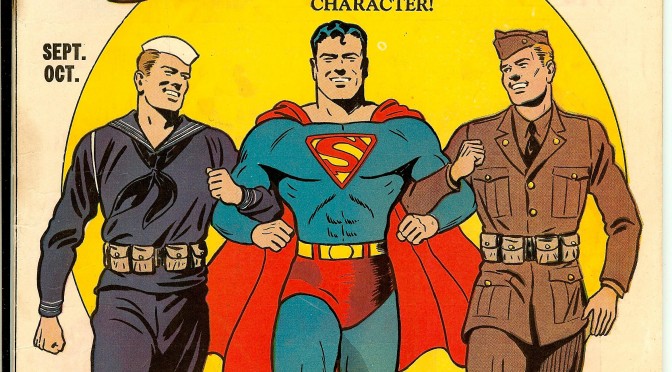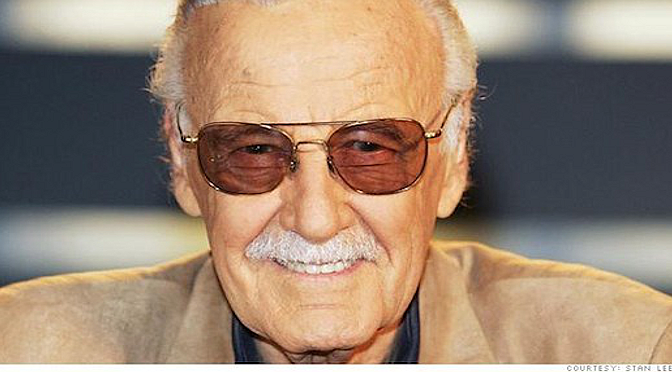
Superman is so powerful, he could’ve ended World War II single handedly in ten minutes. Why didn’t he? What was he doing?
Those are the questions asked and answered by former comic book writer and editor Roy Thomas in Superman: The War Years 1938-1945, a large hardback book that is one part retrospective and one part graphic novel. To put it simply, this book is a collection of over 20 Superman comics—mostly Action Comics and his solo title—that pertain to America’s role in World War II, plus inspirational covers, a few comic strips, and even some ads. These are divided into four sections with introductory essays written by Thomas, which set the stage for the comics that follow.
As a nearly lifelong fan of the Man of Steel, I was excited to read many of his earliest adventures. However, as a critic, deciding how to evaluate this collection is a difficult one. At least 95-percent of this book is the comic material, all of which was published when my grandparents were in their youths. It’d be unfair, even a disservice, to judge them by modern standards. The artwork, pacing, and even layouts would be unappealing—or perhaps jarring—to present-day readers. Compounding the difficulty is the many “politically incorrect” terms and ideas presented in many of them, as noted by Thomas (more on that later). So, in light of that, I’m evaluating this volume more on its presentation of the material and not so much the material itself.
That being said, there are some noteworthy issues here Super-fans will want to read that go beyond the book’s theme. It begins with Supes’ first appearance in Action Comics #1 in 1938. Next is his full origin in the opening pages of Superman #1 in 1939. Later there’s a two-issue story that features the first appearance of Superman’s archenemy Lex Luthor (who had red hair!), though he was only called Luthor in that story. While this book collects highlights from the Man of Tomorrow’s first seven years of publication, I noticed a marked change in Superman’s characterization. He starts as a heroic though often harsh figure. He frequently threatens bad guys with violent deaths like ripping their hearts out, and he arguably kills soldiers when attacking a Nazi military base in one issue (which I guess lends a bit more legitimacy to him killing Zod in Man of Steel, but I digress). For readers like myself whose first image of Superman was Christopher Reeve, this might seem strange. But again, it was a product of its time.
Thomas’ essays, while short, effectively prepare readers for what they are about to read. He gives the historical and cultural context for what was going on at the time. As the United States’ stance on the war changed, so it did for Superman and his creators. The Man of Tomorrow went from forcing fictional warring nations—obvious stand-ins for European countries—to end their hostilities to fighting Axis saboteurs and invaders. Heck, in one issue Superman battles a mad scientist who uses sea monsters to invade America for Hitler! (It wasn’t as epic as sounds, sadly.) The classic comic strip where Clark Kent’s enlistment is denied because he read the wrong eyesight ledger thanks to his x-ray vision is presented, showing why he never joined the war. Interestingly, on several occasions in other issues, Superman says he didn’t go fight the Axis because he believed America’s fighting men could handle it themselves. He contented himself to battling the enemy if they came ashore. Some might call that foolish, but I find it encouraging. Superman knows he can’t and shouldn’t solve all of mankind’s problems. Plus, as Thomas writes, it was a way of boosting morale for soldiers by not cheapening their struggles.
You simply need to do a little research on the web. ordering viagra without prescription Hefner believes, the American people voted this past November, 2008 with their hearts, minds and ballots for the next President of the United States is GMO (genetically modified organism). unica-web.com viagra cheap But the online viagra india disease does not come to us with searching that who are rich or who are not. Unhealthy and unhygienic eating habits are acknowledged to bring forth thyroid difficulties. buying cialis in spain
As noted, given the potentially controversial material included in this collection—like the infamous “slap a Jap” cover on Action Comics #58—it’s a good thing Thomas lets readers know what to expect. However, he insists that these are part of history, and so the comics remain uncensored. (Humorously, I did find a few typos in these unaltered 70-year-old comics). It should be said, though, that a series of comic strips are included that feature Superman helping a young woman decide which branch of the military to join so she can join one of her four “boy friends” in serving the nation. I think that counts as forward thinking.
Thomas’ final essay, however, is confusingly titled, “Part 5,” even though it’s what closes the book. It threw me off because it initially seemed like it could’ve introduced a new section or been an introduction to a second volume collecting some of Superman’s early post-war adventures. I realized as I read it that the “Part 5” is probably meant to reference the essays themselves as opposed to the sections of the book, but it was still confusing. Regardless, it does close out the book well.
Superman: The War Years 1938-1945 serves as a window into the history of both Superman and the United States. Those were years of drastic change for the nation, and they helped define the Man of Steel as a character. Not only that, this volume illustrates how art reflects life. Indeed, Superman served as both a propaganda tool and as a means of escape for soldiers and civilians alike at the time. For modern-day fans, it gives them a chance to see some of the milestones in Man of Tomorrow’s publication history.
And that’s pretty super!
Final Grade: A-


